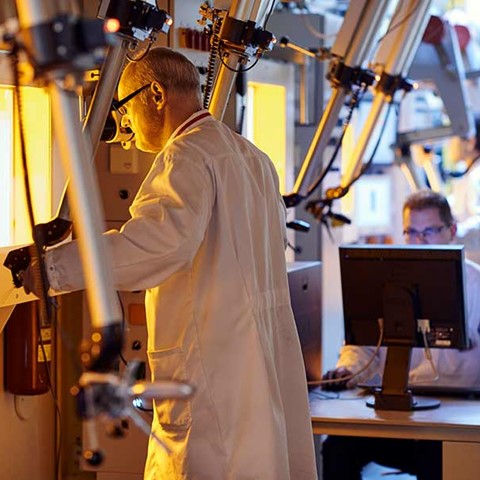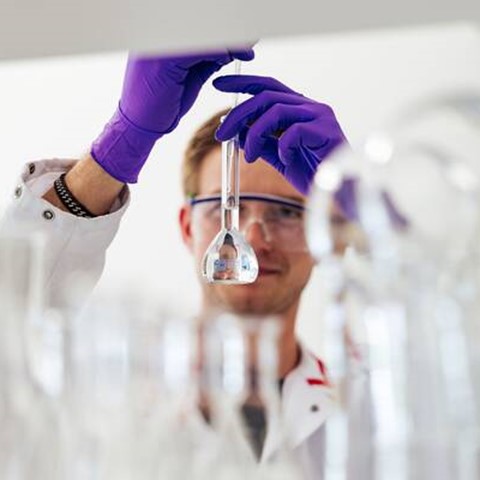Lutetium-177 no carrier added: practical aspects in process transfer from R&D to GMP production in FIELD-LAB
Lutetium-177 no carrier added: practical aspects in process transfer from R&D to GMP production in FIELD-LAB
07 February 2023
Already in 2001, NRG supported the development of Peptide Receptor Radionuclide Therapy with carrier added Lutetium-177 (Lu-177 c.a.) by the supply of Lutetium-177 trichloride as a radiochemical. Nowadays, Lu-177 no carrier added is preferably used. “Lu-177 n.c.a. has a higher specific activity and thus radiolabeling efficiency, than lu-177 c.a.”, according to Marion Chomet, lead scientist at FIELD-LAB. Chomet and her colleagues are now fine-tuning and finalizing their custom made lutetium-177 n.c.a. process. But there are several challenges and practical considerations that they are facing.
Subscribe to our newsletter!

Customer made process
The process for Lu-177 n.c.a. was custom developed and designed by the FIELD-LAB team themselves. Recently, Marion Chomet gave a presentation on the practical aspects of this development at the NKRV meeting at the VUmc in Amsterdam. “Our goal is to create a small-scale production process of Lu-177 n.c.a. as an Active Pharmaceutical Ingredient (API) under Good Manufacturing Practice (GMP) conditions”, says Chomet. “As our process uses especially designed equipment, we need to be sure that the equipment is robust and will be validated. It is not that we bought it ready-made from a company, that guarantees quality.”
In order to be able to transfer the process from the R&D lab to GMP production, the process is being designed to be handled in hot cells, using telemanipulators. Chomet: “All the equipment has been designed, but we are still optimizing. The current process is almost completely automated. However, some manual handlings are still required and need to be able to be performed with telemanipulators within the hot cell. Another challenge is that we work with multiple tubings and connecting parts. We would like to use as many disposable materials as possible to prevent extensive validation of materials that needs to be reused. However, if you have, for example, a leakage or you need to replace a piece of disposable equipment, this will not be as ‘easy’ in a closed hot cell as it was in the R&D setting, in which every part of equipment is easily accessible. In that case fixed materials might be the better choice.
Carrier added versus no carrier added
But what is the difference between Lu-177 c.a. and Lu-177 n.c.a.? The difference lies in the production route. Carrier added is produced, using a direct irradiation method in which Lu-176 is irradiated. However, Lu-176 is not removed in the process, lowering thus the specific activity as both Lu-176 and Lu-177 are isotopes of Lu-177. Also, the direct method leads to the side production of the radioactive impurity Lu-177m (t1/2=160 days) which poses issues regarding radiation protection and disposal of Lu-177 waste in hospitals.
The indirect method for Lu-177 n.c.a. uses enriched Ytterbium-176 as target material, generating a very low amount of Lu-177m. The Lu-177 produced is further processed and separated from the irradiated Ytterbium material ensuring thus a higher specific activity. In the n.c.a production route, Lu-177 is chemically close to Yb-176, but can still be isolated . However, via this method the ratio Yb:Lu after irradiation is about 5000:1, which poses a great challenge for separation of Lutetium from Ytterbium.

“The advantages of our approach, is that we can efficiently separate Lu-177 from Yb-176, collect both separately and recover the target material for recycling purposes."
Production process
After irradiation in the HFR, the quartz ampoule containing the irradiated Yb-176 is broken using a prototype crush tool, whereby the target material is dissolved and further mixed in solution with different chemical reagents. “The advantages of our approach, is that we can efficiently separate Lu-177 from Yb-176, collect both separately and recover the target material for recycling purposes. In theory, the process is also scalable in a proportional way, so if we would irradiate more target material, we should be able to provide more Lu-177 n.c.a end product”, Chomet explains. The Lutetium and Ytterbium are separated by column chromatography, using a series of separation columns. After isolation of the fraction with Lu-177, the solution is concentrated and purified to obtain 177LuCl3 in 0.04M HCl, which will be dispensed and delivered to partners.
Quality controls
There is a European Pharmacopeia monograph for the quality control of Lu-177 solution for radiolabelling, specifying which minimum requirements must be met. FIELD-LAB, however, has in some aspects stricter criteria than the monograph, especially regarding metal impurities such as Iron. “We know what is needed to obtain a high radiolabelling efficiency. Iron, for example, is critical. There is a limit set by the pharmacopeia, but we aim at way less, because we know it will have a positive influence on the radiolabelling efficiency and consequently the quality of the radiotracer will be greatly improved”, Chomet says.

Major Milestone
Finally, we are currently testing all critical process parameters and listing all materials to be used. We have performed a material risk assessment (MRA) for the chemicals and are currently busy with the MRA of the materials and disposables. Some of them will probably require testing via an Extractables and leachables study to ensure, for example, that no metals or other contaminants might end up in our end product.”
Once the process will be ready to be implemented in FIELD-LAB, Chomet and her colleagues will be able to provide a few patient doses of Lutetium-177 n.c.a. under GMP conditions for clinical phase I and phase II studies, a major milestone for FIELD-LAB.
More information?
Do you wish to learn more on Lutetium-177 n.c.a. and how FIELD-LAB can help you? Get in touch with us!

